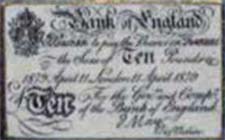|
Introduction
The eighteenth
century was the beginning of modern day banking in England. It was an
exciting era in the economic realm, as it led to the emergence of modern
financial institutions. International trade, as well as war with France
, played a key role in the development of banks. During this time, many
significant events took place, including the advent of the check and
banknote, the founding of the Bank of England, and the first instances
in British history of inflation and forgery.
|
Banks
originated from goldsmith houses
Many of the
services provided by banks were merely a continuance of those
offered previously by merchants, brokers and goldsmiths of the
city. Indeed, it was the goldsmith houses of the late seventeenth
century that became the banks of the 1700’s. The goldsmiths
were well-to-do men with secure lodgings. The future bankers were
not simply keepers and dealers of coin. They were men whose promises
to pay were widely accepted as legal money. They were men of character
and integrity.54
They issued endorsed receipts, which one could return to collect
his money. Shown to the left is a picture of Child & Co’s
first issued banknote, issued in 1729.55
Anyone kept
money with them might write a letter giving instructions to transfer
a certain amount of money into another persons account. Thus,
the concept of checks was born.56
Indeed, the coin shortage resulted in unregulated private bank
notes supplying the need for money in circulation.57
The birth of banks can be, in part, attributed to British imperialism.
The new avenues of international trade and commerce necessitated
financial institutions to provide and move capital (Price 52).58
Shown to the right is a chart, which shows the growing number
of British banks during the eighteenth century.59
|
|
Child
and Co.'s
First
Issued Banknote55

|
Emergence
of Banks in
the
Eighteenth Century59
| Year |
Banks in London |
| 1750 |
20 |
| 1765 |
30 |
| 1770 |
50 |
| 1800 |
70 |
|
Bank
of England
The Bank of England began in 1694 when King William III asked
a wealthy friend and merchant, Mr. Patterson, to underwrite the
cost of the ongoing war with France. This favor resulted in the
founding of a limited liability, privately owned, joint-stock
bank. The Bank of England quickly grew and soon handled all of
the government’s securities. Besides acting as the banker
for the government, the Bank of England served another important
purpose: it released the very first banknotes. These notes were
handwritten for an exact amount of money, signed by the
cashier of the bank and could be redeemed for gold and silver
coins. During the latter half of the eighteenth century, the bank
began printing notes with fixed sums (see picture to the right).
They were available in denominations from £1 to £1,000
during the eighteenth century (although the smaller bills were
not released until very late).60
The Bank
of England introduced almost as many problems as it solved. The
issuance of notes contributed to the first wave of counterfeit
money. As a result, the Bank of England eventually began printing
the bills on paper with visible watermarks, although these were
not manufactured until the nineteenth century. Also, the increasing
national debt (due to the Napoleonic Wars), led Parliament to
halt the redemption of banknotes for gold and silver coin. This
period, known as “The Restriction Period,” caused
the first instance of inflation in the English economy. It was
a trend that would continue far into the future.61
|
|
Bank
of England's Printed Ten £ Banknote60

|
| Act
of 1708
Despite the imperial commerce’s demand for financial institutions,
the growth of banks was hindered by the1708 Act. The 1708 Act restricted
banks with more than six partners from issuing bank notes. Therefore,
most banks remained as partnerships in order to retain the ability to
issue notes. However, banks were inherently unstable because the death
of a partner could effectively shut down a bank. Indeed, in 1784, only
seven British banks had more than one office. One of the pioneers of
these allied but separate offices, Abel Smith is shown below. The small
size and instability would be features British banks would retain until
well into the nineteenth century.62
|
Banks
had different functions
Banks arose according
to the various need of the people. By the end of the eighteenth century,
three main types of banks were in operation:
- West end banks:
Hoares, Coutts, Childs and Drummonds were mainly involved in business
with the aristocracy, gentry, government (securities) and wealthy
lawyers.
- East End banks:
Martins, Curries, Glyn Mills, Mastermans made loans to the members
of the stock exchange, did business with traders and manufacturers,
and acted as liaisons for country banks.63
- Country banks
started springing up in the latter half of the eighteenth century.
There were less than a dozen before 1750. Their arrival was due mainly
due to the recoinage of guineas in 1774, which created a special need
for banks to collect coins and provide alternative currency.64
|
Abel
Smith, British Banker62

|





